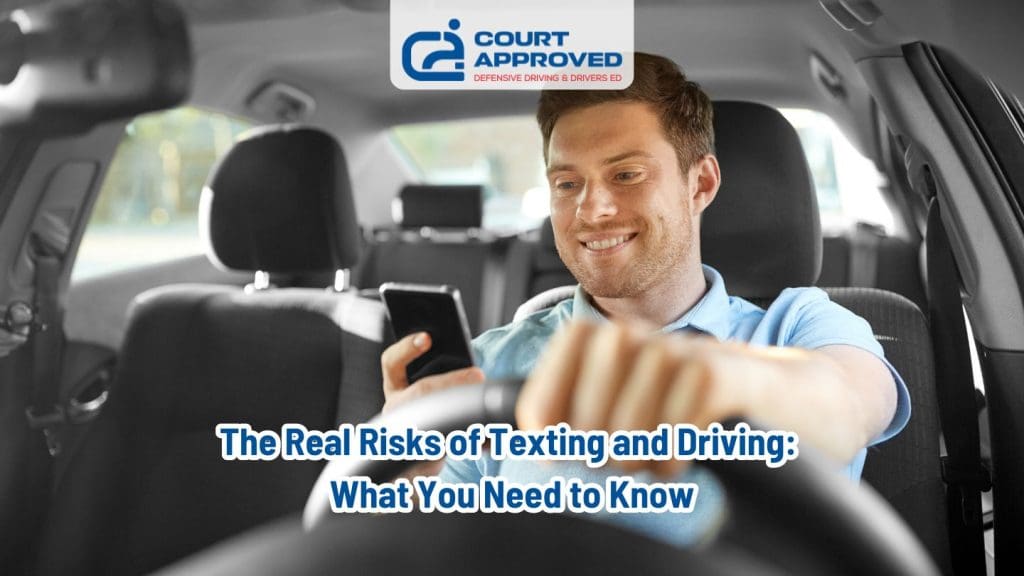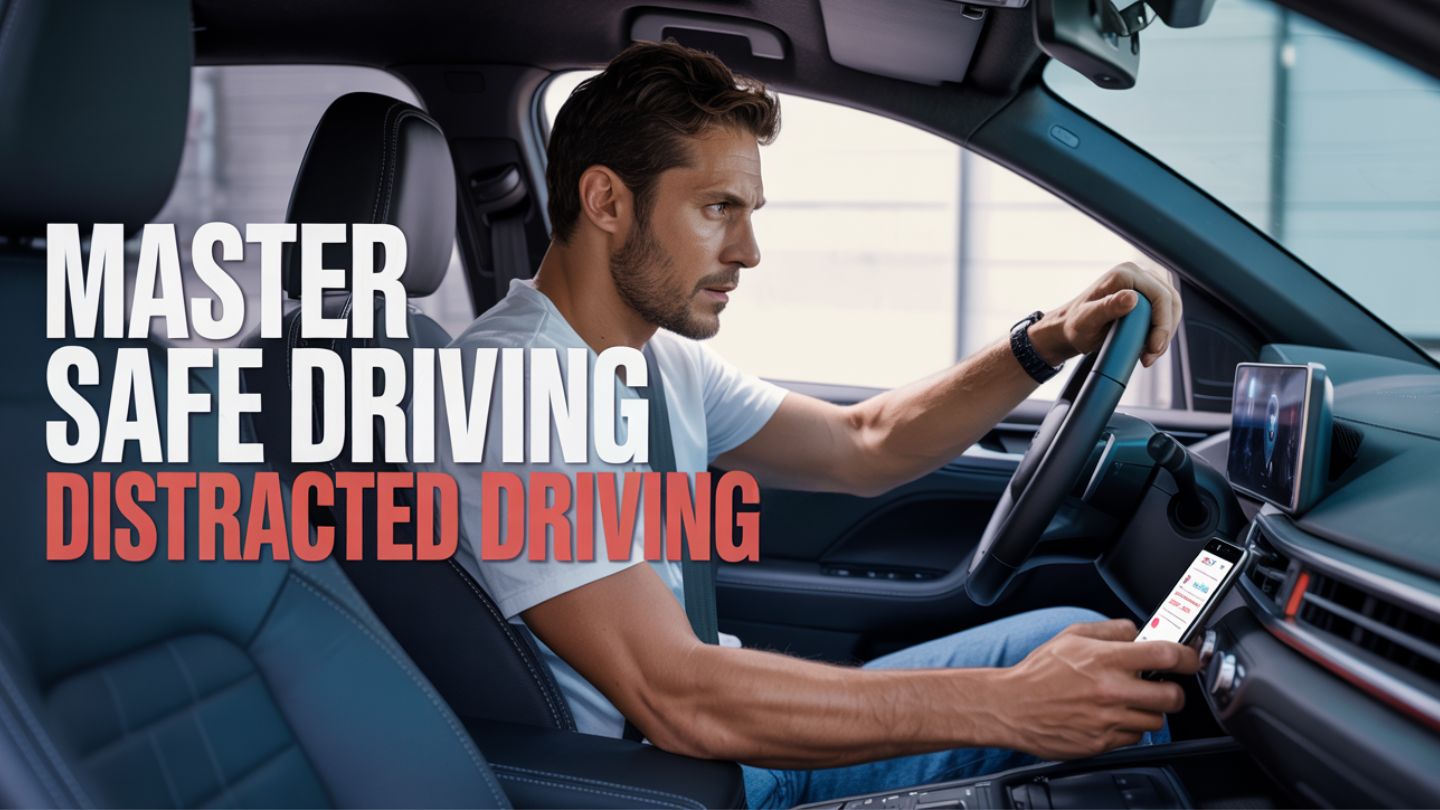Maintaining full attention while driving is crucial, yet many drivers underestimate the dangers of briefly diverting their focus from the road. One of the most dangerous examples is texting while driving, which can cause drivers to take their eyes off the road for about five seconds. Although this may seem like a short period, it can lead to life-altering accidents.
Committing to distraction-free driving is essential in preventing collisions and saving lives. The dangers of texting or using a cell phone while driving are well-documented, significantly increasing the risk of accidents, serious injuries, and fatalities. In just a few seconds of distraction, you could miss important traffic signals, veer into another lane, or fail to react to sudden stops. This article will discuss the immediate risks, legal repercussions, and practical steps you can take to prioritize safer driving.
Key Takeaways
- The dangers of using mobile phones while driving significantly increase the risk of accidents, making it as dangerous as driving under the influence.
- Distracted driving is a leading cause of fatalities, with 3,308 deaths recorded in 2022 in the U.S. alone, emphasizing the importance of maintaining focus on the road.
- Implementing preventive measures like disabling cell phones, educating young drivers, and using hands-free technology can effectively reduce distractions and promote safer driving habits.
The Risks of Texting and Driving
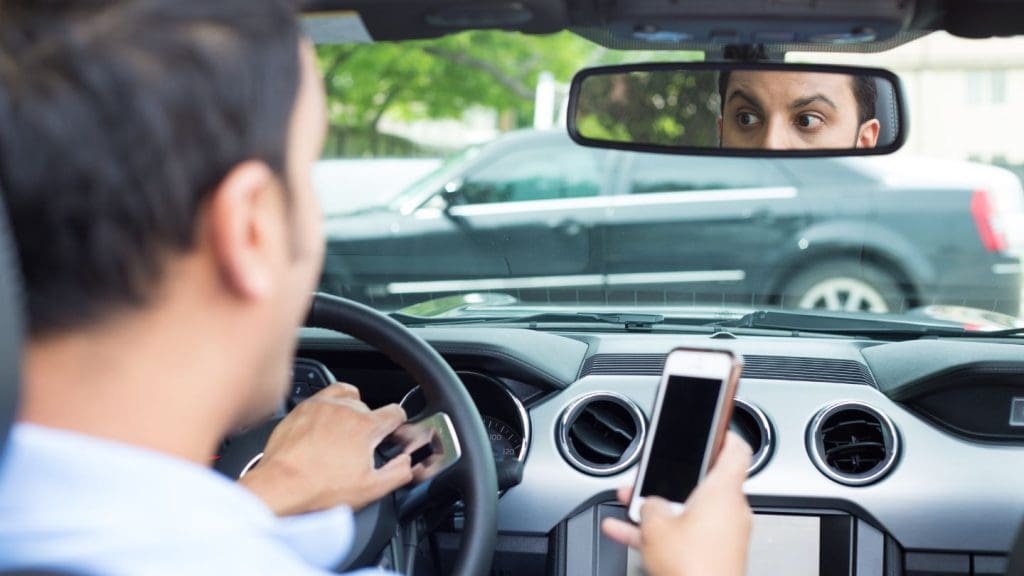
Engaging in texting while operating a vehicle diverts the driver’s focus, significantly increasing the risk of vehicular accidents caused by distracted drivers. The severity of this distraction is comparable to driving the length of a football field at 55 mph with your eyes closed. Such distracted driving behaviors result in approximately eight fatalities daily in the U.S., stemming from collisions where the driver was not fully attentive. The grave risks associated with using a cell phone while behind the wheel range from fatal consequences to substantial injuries and lasting impairments.
The belief that brief glances at one’s mobile phone while driving are harmless is dangerously mistaken. In reality, the detrimental effects on concentration while managing both tasks mirror those encountered by individuals who drive under the influence of alcohol. Reducing smartphone usage while driving can drastically cut down accident occurrences, making awareness about these dangers crucial for maintaining safety on roads.
The data illustrating incidents related to drivers’ use of phones is deeply troubling. It has become one of the leading factors contributing to road mishaps today. To maintain utmost safety, being vigilant and focused exclusively on driving becomes imperative for all drivers—abstaining entirely from engaging with their phones, whether it be through talking, messaging, consulting navigation apps, or scrolling social platforms. Fostering recognition of various distractions and understanding their severe impacts could help significantly curb instances of distracted driving.
The Immediate Dangers of Texting While Driving
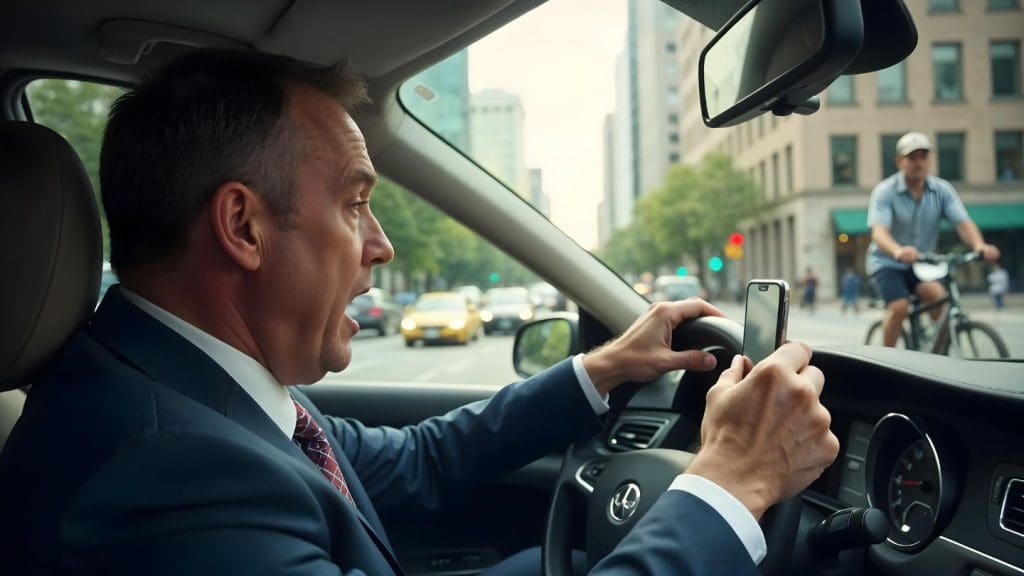
Understanding the three primary categories of distractions caused by texting while driving—visual, manual, and cognitive—is crucial in recognizing the heightened risk of a distracted driving accident. Each type contributes significantly to making driving more dangerous.
Grasping these distinctions is key to understanding why it’s critical to refrain from using cell phones when operating a vehicle, as they underscore the comprehensive dangers involved with texting behind the wheel.
Visual Distractions
When drivers shift their gaze from the road to their mobile devices, they risk overlooking essential traffic cues like red lights or unexpected braking by other vehicles. Such divided focus can cause them to stray into different lanes, collide with cars ahead of them, or hide off-road entirely. Engaging in texting while at the wheel is particularly hazardous since it involves manual dexterity, visual acuity, and cognitive processing, all being compromised concurrently—thus posing a substantial threat.
The likelihood of incidents stemming from distracted driving skyrockets when drivers are visually diverted. Merely glancing away for seconds to read a text message might seem inconsequential but, indeed, endangers everyone on the roadway. The resulting distraction may lead not only to grave accidents involving distractible conduct but also to potential loss of life.
It’s vital that drivers commit themselves fully to distraction-free operation while controlling an automobile—the cornerstone principle for ensuring safety on our roads.
Manual Distractions
Engaging in activities such as texting while driving often requires drivers to remove their hands from the steering wheel, which can considerably hamper their ability to control the vehicle effectively. This action elevates the potential for losing control of one’s car and creates dangerous situations on public roads due to distracted driving.
The competence to navigate a vehicle safely is compromised when drivers are preoccupied with distractions that necessitate manual input. Such diversions significantly elevate the risk of being involved in motor vehicle crashes because these drivers may not be prepared or capable of adapting promptly to unforeseen shifts in traffic dynamics.
Adopting hands-free technology could potentially minimize these dangers by allowing drivers’ hands to remain on the wheel. This solution isn’t entirely fail-safe. The most secure method is always keeping both hands firmly on the wheel and dedicating complete attention to navigating one’s path without distraction.
Cognitive Distractions
Driving demands complete mental focus, yet interacting with cell phones disrupts this concentration. This shift in attention due to mobile device usage significantly increases the likelihood of collisions by reducing situational awareness. Even hands-free technologies, while minimizing physical interactions, fail to completely eliminate cognitive distractions since conversations still divert mental attention from driving.
Absorbing a text message or engaging in a phone call while driving diminishes attention to essential driving tasks, thereby increasing the risk of accidents linked to distracted driving. Hands-free options may offer a false sense of security, potentially leading to unsafe practices on the road.
For genuinely distraction-free driving, it is best to avoid using your cell phone altogether while operating a vehicle. Every driver should aim to maintain undivided focus on the road, completely abstaining from phone interactions, whether directly handling the device or using hands-free systems.
Statistics on Texting and Driving Accidents

The statistics on accidents caused by texting while driving are undeniably troubling. The fatalities and injuries resulting from distracted driving highlight the severe dangers that cell phone use poses on the road. These figures underscore the urgent need for strategies that encourage safe driving practices to mitigate the risks associated with phone use behind the wheel. Additionally, addressing other hazardous driving behaviors is crucial for ensuring overall road safety.
Teen Drivers
Driving while distracted, particularly by using a cell phone, poses significant dangers for teen drivers. Their inexperience and still-developing driving skills make mobile phone use behind the wheel especially hazardous. In the United States, nearly one in three teenagers has admitted to texting while driving at least once. 58% of vehicular incidents involving young drivers are linked to distractions from such activities. To enhance road safety, it is crucial for families to commit to avoiding the use of distracting devices while driving.
Parents play a vital role in educating their teenage children about the dangers of distracted driving. Setting strict rules on cell phone use while driving and having open, honest conversations about the potential risks can be effective strategies to mitigate these dangers. The benefits of refraining from cell phone use while teens are behind the wheel far outweigh any inconvenience, as it prioritizes the safety of everyone on our roads and highways.
Older Drivers
Despite their extensive driving experience, older drivers can sometimes overlook the risks associated with distracted driving. This oversight can lead to hazardous situations on the road.
It’s essential for senior motorists to stay vigilant and avoid any distractions while driving to ensure the safety of everyone involved.
Legal Consequences of Texting While Driving
Texting during driving is not only a significant distraction, but it can also lead to severe legal repercussions. If caught engaging in this behavior, drivers may face hefty fines, the loss of their driving privileges, and potentially jail time if their actions result in injuries or fatalities. The projected increase in fatalities due to distracted driving underscores the critical need for drivers to focus on the road and avoid any distractions while operating a vehicle.
State Laws
Numerous states have enacted clear legislation that forbids the use of handheld cell phones and texting while driving. Many states enforce a ban on using handheld devices while operating a vehicle, allowing for citations to be issued without any other violations present. However, some states do not impose restrictions against texting behind the wheel. Those found breaking these rules may face penalties such as fines or points added to their licenses.
The purpose of these regulations is to encourage safe driving habits and decrease distracted driving incidents caused by phone use. Drivers can play an active role in making roads safer by complying with local laws that restrict cell phone use while driving, thereby helping to minimize accidents due to distractions from phones.
Insurance Implications
Being cited for driving while texting can result in higher insurance costs due to the increased risk associated with the driver. After being fined for an offense related to texting, a driver may see a substantial hike in their insurance rates, highlighting the economic repercussions of distracted driving. Repeated incidents of distracted driving could even lead insurers to refuse coverage to drivers.
Enrolling in a defensive driving program can alleviate some of these negative outcomes by potentially lowering one’s insurance premiums and leading to ticket dismissal. It assists drivers in steering clear of accumulating points on their license, which can influence their insurance expenses.
Preventive Measures for Safe Driving
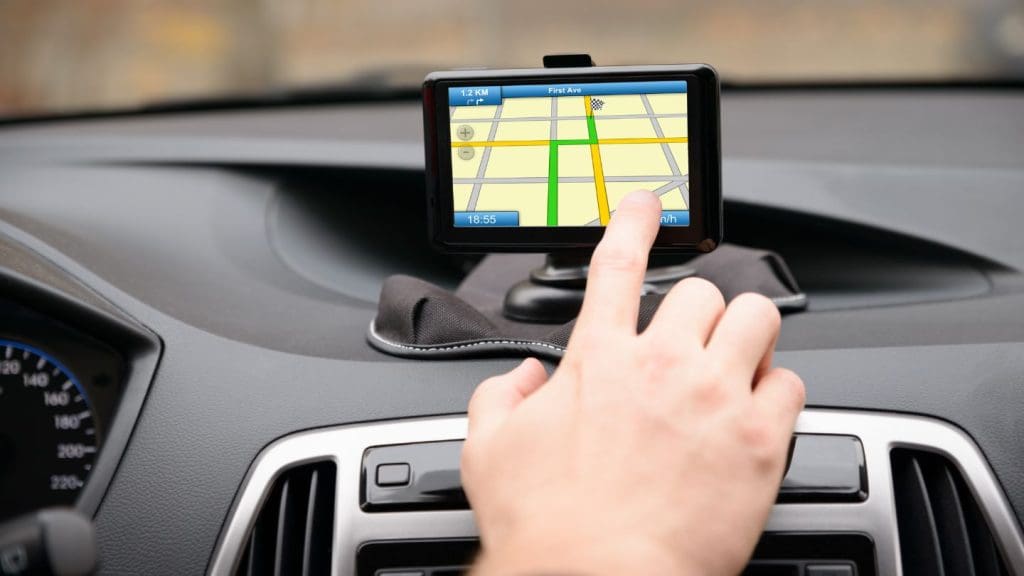
To enhance road safety, it is essential to implement strategies that eliminate potential distractions and minimize risky driving behaviors. One effective approach is to switch off cell phones and place them out of reach before starting your journey, which can significantly reduce the likelihood of accidents caused by distracted driving.
By minimizing distractions, drivers can maintain their focus on the road, thereby fostering safer driving habits.
Using Hands-Free Technology
Hands-free technology enables drivers to place calls without the need to hold a phone, aiming to minimize distractions that stem from physically handling the device. Despite reducing manual interference, these technologies cannot alleviate mental distractions since engaging in conversation still diverts focus away from driving tasks. Studies indicate there is an equal likelihood of accidents occurring among drivers using hands-free devices as with those who use handheld phones.
While hands-free solutions might appear more secure, they can foster a misleading sense of safety and promote risky conduct behind the wheel. Evidence from certain areas indicates a dip in collision claims subsequent to banning handheld phone usage while driving, suggesting such prohibitions are beneficial.
Nevertheless, forgoing any kind of phone use when operating a vehicle remains the most prudent strategy for safety.
Setting Up Navigation Systems Before Driving
To mitigate distractions that may arise from adjusting navigation systems while on the move, it is vital to configure them before initiating your drive. Planning your journey and organizing navigational aids in advance help eliminate distractions en route. Such preparation is particularly critical for novice drivers who might find the technology interfaces within their vehicles challenging.
Initiating travel with preset navigation systems allows drivers to stay attentive and fosters a safer driving environment. By taking this straightforward step, one can reduce the likelihood of accidents caused by distracted driving and cultivate habits conducive to safe driving practices.
Educating Young Drivers
It is essential to engage young drivers in detailed discussions about the perils of using a mobile phone while operating a vehicle. Imposing strict regulations regarding phone use can reinforce critical, safe driving practices for adolescents. It’s crucial for parents to emphasize the significance of focused attention on the road and convey the hazards associated with being distracted by cell phones when behind the wheel.
Raising awareness among novice drivers about how dangerous distracted driving is could be life-saving. Creating an environment that prioritizes safety and accountability helps prepare new generations of motorists to competently navigate potential difficulties encountered while driving.
How Defensive Driving Courses Can Help
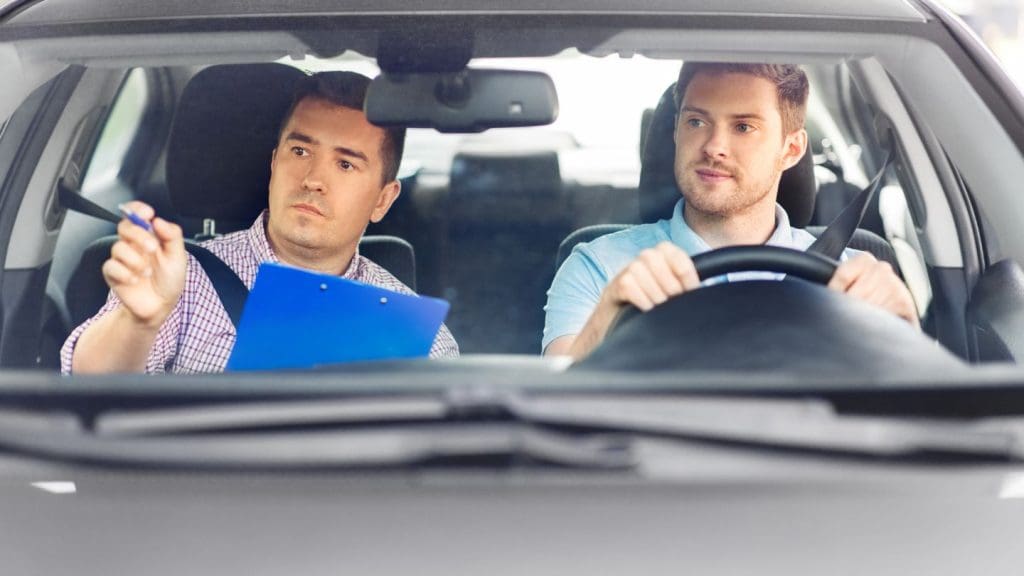
Defensive driving courses offer an excellent opportunity to enhance driving skills and promote safe driving practices. These courses are self-paced, allowing participants to complete the material either all at once or over several days, accommodating various schedules.
By enrolling in a defensive driving course, individuals can potentially have traffic tickets dismissed, enjoy reduced insurance premiums, and significantly improve their overall driving safety.
Structure of Texas Defensive Driving Course
The defensive driving course in Texas is designed for flexibility and convenience. Participants can choose to complete the entire course in one sitting or spread it out over multiple days, allowing them to manage their time effectively while enhancing their driving skills.
Whether you decide to go through the course in a single session or break it up into smaller segments, the Texas Defensive Driving course is structured to accommodate your schedule.
Benefits of Taking the Course
Taking a defensive driving course in Texas offers several significant benefits, including the ability to dismiss a traffic ticket once a year. This helps maintain a clean driving record and prevents potential hikes in insurance premiums. Furthermore, completing the course can lead to insurance discounts, providing financial savings for drivers.
Besides the financial advantages, participating in a defensive driving course enhances driving skills by focusing on essential techniques and improving judgment, which are crucial for safe driving. The skills acquired during the course not only boost personal safety but also enhance the overall safety of all road users. By promoting better driving habits, these courses play a vital role in creating safer road conditions for everyone.
Summary
Texting while driving is a dangerous behavior that diverts attention from the road, leading to severe consequences. The statistics and facts presented highlight the immediate dangers, legal repercussions, and preventive measures that can help ensure safe driving. By understanding the risks and implementing strategies such as using hands-free technology, setting up navigation systems before driving, and educating young drivers, we can reduce the incidence of distracted driving accidents. Remember, attentive driving is one of the most effective ways to stay safe on the road. Let’s commit to distraction-free driving and make our roads safer for everyone.
At Court Approved Defensive Driving, we understand how important it is to promote safe driving practices. We provide a defensive driving course in Fort Worth designed to educate drivers and prevent accidents caused by distracted behaviors like texting. Whether you’re seeking courses for legal requirements or want to improve your driving skills, our services are here to help.
Visit Court Approved Defensive Driving today and take the first step towards safer, more responsible driving. Together, we can make a positive impact on road safety. Contact us today to learn more about our courses and how we can assist you in becoming a safer driver.

